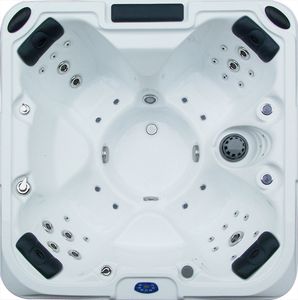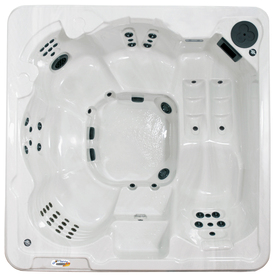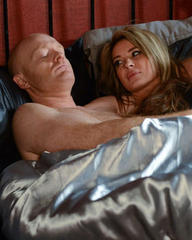
outdoor wood burning hot tub
image

Ehehdogeh
I need help finding a cottage/cabin rental in Wisconsin. I prefer the lower half of the state - I don't want to go further north than Door County. The ideal rental will have no more than a 2-night minimum (the week of October 8), is in the woods, relatively secluded, on a lake or river, sleeps 2 and has an outdoor hot tub.
Do you know of such a place? I have googled and googled but have only found one that meets my requirements.
Alternatively, if you KNOW of a site where I can search that allows you to select the amenities you want, that would be great. I've come across some that allow you to search for some things, but I want to be able to limit searches only to those with outdoor hot tubs.
Any help will be greatly appreciated!
Answer
hello there,now im praying to the good lord that these are going to help you,you sound pretty desperate,
Birch Lake Secluded Getaway
21476 Inshore Ave, Tomah, WI - (608) 374-3150
"... Birch Lake Secluded Getaway, Tomah Wisconsin vacation cabin rentals with hot tubs in central WI near the Wisconsin Dells resorts cottages cabins lodging ..." birchlakegetaway.com
Sherwood House in Colorado
896 Young Road, Hudson, WI - (888) 755-8595
"... Every amenity imaginable, from the 60' big screen TV home theatre, the two jetted tubs in the bathrooms, the eight person hot tub on the deck, fully-equipped ..." rentalo.com
Best Western Derby Inn
Hwy 45 North/ P.O. Box 2470, Eagle River, WI - (715) 479-1600
"... Many of the features that separate The Derby Inn from others include a large heated pool and an over sized hot tub & sauna. We also offer guest laundry, ..." derbyinn.com
D Scott Diller Llc: Diller D Scott CPA
1263 Willow Grove Dr, Pewaukee, WI - (262) 695-9100
"... Vista Verde Northâs private heated pool and hot tub are located just steps from your door. This secluded and relaxing oasis is said to be the most beautifully ..." floridavacations.com
M & M Victorian Inn
1393 Main St, Marinette, WI - (715) 732-9531
"... We have two suites each with a two person jacuzzi tub, one with a private wood burning fireplace, and both with an amazing original stained glass windows. ..." wbba.org
Hidden Valley Inn & Resort
W7724 County Rd W, Phillips, WI - (715) 339-2757
"... This rental includes one bedroom on the first floor with a king size bed, and a sleeping loft with a full and two twins. Air conditioning, two baths, hot tub, ..." cottages.org
Econo Lodge
700 E Main St, Watertown, WI - (920) 261-9010
"... Free local calls; Car rental desk; Family rooms; Wheel chair access; Pets allowed; Free parking; Meals; Economy; Hot tub; Free breakfast; Nonsmoking; Data port ..." hotel-guides.us
Super 8 - Eagle River
200 W. Pine St, Eagle River, WI - (715) 477-0888
"... Our amenities include: Whirlpool suites, king suites, indoor pool, hot tub, sauna, conference room, super start breakfast, cable TV and a 24 hour front desk. ..." eaglerivervacations.com
Courtyard-Milwaukee Downtown
300 W Michigan St, Milwaukee, WI - (414) 291-4122
"... There were a lot of kids in there and voices would echo, which made it hard to relax in the hot tub. Parking was $15, but the ramp was connected right to the ..." tripadvisor.com
Jacobson Terry & Sally
21476 Inshore Ave, Tomah, WI - (608) 374-3150
"... The resorts also offer ice skating, nature trails, duck watching, turtle teasing, stargazing, campfire roasting, hot tub soaking, or just plain old deck loafing ..." findrentals.com
Phones Plus Inc
2745 S Calhoun Rd, New Berlin, WI - (262) 784-2311
"... Full wrap-around deck with private hot tub for those cool nights included. Professionally decorated with a 'North Woods' decor.Ravenswood lodge is located in ..." vrbo.com
Re/Max Preferred Real Estate
100 E Main St, La Valle, WI - (608) 985-8484
"... You'll love the kitchen/dinette and the big living room complete with a fireplace and access to the lakeside deck & hot tub. 2 Car detached garage offers nice ..." realtytimes.com
i may help better if you knew the exact location,theres hundreds for door county!! can you give a specific town? hope this as helped a little good luck in your search,best wishes...
What do I need to know about bearded dragons?

Alex C
I want to get a bearded dragon, but I need to know how to take care of it, what to feed it, pricing, cleaning, health problems, and anywhere I can watch videos on the bearded dragon.And finally how to convince my mom about any qualities of a beardie.
Answer
Housing:
The larger the better when it comes to enclosures for adult bearded dragons. Hatchlings can be housed in as small as a 10-gallon enclosure, but a minimum size for an adult is a 50-gallon terrarium. Rubbermaid tubs also work well for groups of young dragons. We suggest a minimum 15 gallon tall tub, with the lid turned into a screen top. Cut a large hold in the top, and use Liquid Nails to glue the screen to the plastic top. Enclosures should typically be longer than they are high. Groups of adult dragons should be housed in larger enclosures with numerous logs for basking. Glass is a great choice for display of adult bearded dragons, allowing for optimum vision and brightness, but hatchlings often do better in enclosures that limit vision. It is also thought by many keepers that dragons display better color when housed in enclosures that they cannot see out of. Please be wary of housing young females with males. Dragons may mate at young ages and run into complications with egg binding.
Substrate/cage decor:
Although sand has been used for many years, I recommend strongly to my customers to use wheat bran for bearded dragons above 6 month of-age. We suggest housing young bearded dragons on newspaper or paper towels to prevent problems with impaction. With newspaper, be aware that crickets will hide beneath the paper. We suggest that you replace the old paper with new paper nightly, allowing hidden crickets to be removed or eaten for a late night snack. Left over crickets can harm young dragons, so be careful. If there are extra crickets in the enclosure, provide them with food, so they do not nibble on your dragon at night. Basking logs should be placed within the enclosure to allow your dragon to thermoregulate and feel secure. Decorative rocks and fake plants may also help to liven up the enclosure. Do not use heat rocks. Bearded Dragons sense heat and light using a detector located on top of their heads. They are not as aware of heat coming from below and can badly burn their bellies without knowing it. For this reason we advise to not use a heat rock or place rocks too close to the basking light. Use wood logs for basking zones instead. Live plants may also be an option. (But live plants must not be toxic, as they will likely be dinner).
Lighting/heating:
Bearded dragons like it HOT! The key to heating your enclosure is providing a temperature gradient from a hot basking zone, to a cooler area. Basking temps should reach well over 100 degrees F. The cooler zone should be around 85 degrees.
The brighter the light, the better. Dragons thrive under a good full spectrum UV source. We recommend active UV/heat or mercury vapor bulbs. These bulbs work double time to give your dragon quality UV and producing heat at the same time. You may also use fluorescent UV full spectrum tubes, although they do not produce the same UV quality. The colors and health of your lizard depend on good heat, bright light and UV. Your dragon will also benefit from natural sunlight and we recommend bringing your lizard outside in an outdoor basking enclosure. However the more natural sunlight you expose them to, the less supplements you should give, especially vitamin D3 (this may also be the case when using the active UV/heat bulbs). We also think that younger dragons may become stressed when taken outside, and therefore suggest holding off on outdoor excursions until your dragon is older .
Behavior:
Bearded Dragons are generally not aggressive towards people, but will attack other dragons, and many other species of lizards, frogs, etc. Never put a small dragon with a larger one, as the small dragon may end up dinner. Beardeds tend to spend the day running from one heat zone to the next, and often searching for food. A happy healthy dragon is alert, fast, and active. Young dragons can be kept in groups without too many problems associated with stress, but older males should be kept one to a cage. Breeding groups of 1 male and 2-5 females are not uncommon. Males will aggressively bob their heads at the females, while the females will wave their arms in circles back. Males and some females will also turn their beard jet black. These are part of the breeding rituals and territorial behaviors of bearded dragons. Adult Bearded dragons enjoy basking lazily on their logs. Your dragon may "vent" (open mouth breathing) while basking, this is very normal and not a sign of distress. It is also not uncommon to find a dragon sleeping at night in what appears to be the most painful position on earth.
Longevity:
A well cared for dragon will live from 6-12 years, maybe longer. The early years of a dragons life are often the most important. A young dragon that is not properly cared for is likely to have life long lasting problems. Proper exposure to uvb, vitamins, and minerals along with a well balanced diet in every stage of a dragon's life will help enable your dragon to have a long and healthy life.
Feeding/supplementation:
Bearded dragons are omnivorous and should feed on both vegetation and protein. Crickets, mealworms, superworms, and a salad mixture should be staple food sources. Never feed your dragon too large of a prey item. We suggest feeding prey 1/2 to 3/4 the size of the space between your dragons eyes.
Dragons require a variety of greens including collard greens, red leaf lettuce, green leaf lettuce, mustard greens, turnip greens, and dandelion greens. Stay away from iceberg lettuce, large amounts of kale, cabbage, or spinach. We also suggest a variety of vegetables such as carrots, squash, sweet potatoes, peas, corn, and fruits offered in small amounts. Other specialty additions can include cactus fruit, dandelion flowers, and hibiscus flowers. This salad mix can be offered daily using different combinations of ingredients.
When feeding crickets, make sure your source of crickets is clean. You may gutload your crickets with commercial cricket and/or we suggest offering your crickets fresh fruit, greens, and water. Remove all old food from your cricket container. Mold can be toxic to your lizards. We suggest using a moistened paper towel/sponge, citrus, or carrots to provide water for your crickets.
Whenever possible try and provide a variety of appropriate sized prey items for your dragon including super worms, silk worms, roaches, grasshoppers, preying mantis, and a variety of other bugs (not fireflies). However we strongly suggest not using bugs found outside, as they may have pesticides that can kill your dragon. Also, use waxworms in limited amounts, if at all. They contain little nutritional value, and although relished by the dragons, contain high amounts of fat.
You can also feed rep cal pellets to your dragons at a young age. The best method we have found to start dragons on the pellets is to moisten the pellets, and drop them like crickets onto a paper plate in front of the dragons. This will generally trigger a feeding response from the dragons. Generally they will only eat a couple of pellets in the beginning, but with patience and age they will start to feed heavily on the pellets. The pellets have less risk of parasites, associated with much live prey.
You can also feed pinky mice/rats to adult dragons; this is especially good for females during the breeding season.
We feed all of our hatchlings a minimum of three times a day to ensure optimum growth and health. As dragons get older, their appetite will decrease. For adult dragons, you can offer greens daily and crickets or worms 3-4 times per week. As dragons get older, you may decrease the amount of protein offered.
We suggest misting your dragons once a day, especially as hatchlings. Dragons will drink during spraying and may also be "trained" to drink and soak in a water dish inside the enclosure. They also enjoy an occasional warm (not hot) bath.
Supplementation:
There are many different and often contradictory opinions/views on supplementation. Calcium, D3, and vitamin supplementation are necessary for your dragons. However, supplementation will depend on what you feed your dragons, the bulbs you use, and how much natural sun they receive. Many sources recommend supplementing small dragons daily and decreasing to once or twice per week for adult dragons. But both too little and too much supplementation can lead to problems. Therefore, we recommend going over this with your vet to find a schedule that suits the specific needs of your dragon. We suggest you supplement your young dragons daily with a ratio of 1 part Rep-Cal Herptivite to 3 parts Rep-Cal calcium with Vitamin D3.
Diseases & Disorders:
Bearded dragons are one of the hardiest reptiles available in the pet trade, yet they still can succumb to numerous diseases and problems.
We are not veterinarians; please do not use this information as a replacement for taking your lizard to a vet. This information is meant to raise your awareness of signs and possible problems. If you notice that your lizard is ill, do not hesitate to make an appointment with a reptile specialist.
Several pointers to ensure optimal health for your lizard:
Follow all housing, heating/lighting, and feeding/supplementation requirements for your lizard.
Quarantine all new reptiles.
DO NOT HOUSE YOUR BEARDED DRAGON WITH ANY OTHER SPECIES OF REPTILE. Different reptiles come from many different environments requiring different needs in captivity. Even animals that come from similar environments can cause stress and pass parasites onto your dragon, costing the life of your lizard.
Do not house bearded dragons of different sizes together--this is a sure problem for the smaller dragons' health.
We recommend housing males separately. You may even need to prevent males from seeing each other across cages.
Keep your cages and food CLEAN! Clean and sift poop often. Remove all old food.
Wash your hands before and after handling your lizard.
Powered by Yahoo! Answers





























